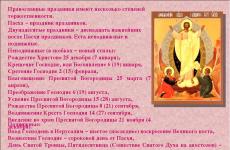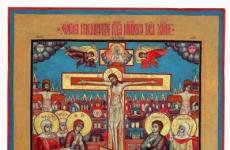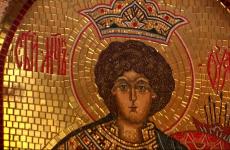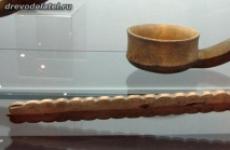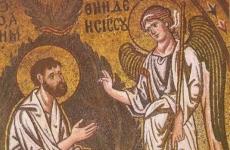Fairy tales for reading to a preschooler in syllables. Texts for teaching reading to preschoolers with pictures, reading assignments. Let's play steam locomotives
A child who has learned to put sounds into syllables, syllables into words, and words into sentences needs to improve his reading skill through systematic training. But reading is a rather laborious and monotonous activity, and many children lose interest in it. Therefore we offer small texts words are divided into syllables.
At first read the story to your child, and if it is long, you can read its beginning. This will interest the child. Then invite him to read the text. After each work, questions are given that help the child to understand what they have read and comprehend the basic information that they have learned from the text. After discussing the text, suggest reading it again.
Smart Bo-beak
So-nya and co-ba-ka Bo-beak gu-la-li.
So-nya played-ra-la with a doll.
Therefore, So-nya be-be-zha-la to-my, and the doll for-would-la.
Bo-bik found a doll-lu and brought it to So-ne.
B. Korsunskaya
Answer the questions.
1. Who did Sonya walk with?
2. Where did Sonya leave her doll?
3. Who brought the doll home?
The bird made a nest on a bush. De-ti our nest-up and took off on the ground.
- Look, Vasya, three birds!
In the morning, de-ti came, and the nest-before it was empty. It would be a pity.
L. Tolstoy
Answer the questions.
1. What did the children do with the nest?
2. Why was the nest empty the next morning?
3. Did the children do well? How would you do?
4. Do you think this work is a fairy tale, a story or a poem?
Pet-ti and Mi-shi had a horse. They began to argue: whose horse. Did they tear each other apart.
- Give me - my horse.
- No, you give me - the horse is not yours, but mine.
Mother came, took a horse, and nobody's horse became.
L. Tolstoy
Answer the questions.
1. Why did Petya and Misha quarrel?
2. What did mom do?
3. Did the children play horse well? Why are you so
think?

It is advisable to use the example of these works to show children the genre features of poems, stories and fairy tales.
A genre of oral fiction containing events unusual in the everyday sense (fantastic, miraculous or worldly) and distinguished by a special compositional and stylistic construction. In fairy tales there are fairy-tale characters, talking animals, unprecedented miracles happen.
Poem- a small piece of poetry in verse. The verses are read smoothly and musically, they have rhythm, meter and rhyme.
Story- small literary form; a narrative work of small volume with a small number of characters and the short duration of the events depicted. The story describes a case from life, some bright event that really happened or could happen.
In order not to discourage reading, do not force him to read texts that are uninteresting and inaccessible to his understanding. It happens that a child takes a book he knows and reads it “by heart”. Necessarily read to your child every day poems, fairy tales, stories.
Daily reading enhances emotionality, develops culture, horizons and intellect, helps to understand human experience.
Literature:
Koldina D.N. I read on my own. - M.: TC Sphere, 2011. - 32 p. (Candy).
Reading for preschoolers is always a new, interesting process. And this is not surprising, because they discover a whole world, previously unknown, unfamiliar.
First, children get acquainted with letters and sounds, then they learn to put them into words. And then the moment comes when the child tries to read on his own. It is impossible to immediately give the baby complex texts for this purpose, and even not divided into syllables. Difficulties encountered in reading can completely discourage the desire to study further. So we will learn to read, taking as a basis stories and fairy tales specially adapted for preschoolers.
Stories for children
If you don’t know which texts to start with, you can buy or download and print collections of texts on our website under the general title “Reading by syllables”. Such literature is specially adapted for children. This does not mean that the stories of famous writers are somehow changed in it: the selection of texts in such books is focused on children of preschool age, and the words in the texts are divided into syllables for reading, which greatly facilitates the learning process for the child.
On our site there are also separate texts with a special division into syllables. They can also be printed out and offered to children for reading.
What stories are best for children?
Of course, these are the works of those writers who specialized in children's topics: M. Prishvin, K. Paustovsky, A. Barto, N. Nosov, Lev Kassil, S. Marshak, etc. It is not necessary to read the stories in full: for young children it will be enough choose one small passage, divide it into syllables and present it for reading.
 How to instill a love of reading?
How to instill a love of reading? How to deal with parents with children on such texts?
Do not leave the child alone with the story if he still does not read well. This can discourage any interest in subsequent learning if the baby has difficulties and he cannot cope with them. Sit next to your child and start reading together. It is very important for children that adults show interest in their affairs. Along the way, ask the baby to help you and read this or that word. When you have read to the end, discuss the passage: have the child retell what he understood from the text. Do not leave what you read unattended: the baby must realize that he is reading not for dad or mom, but for himself, for his own understanding.

You can download a set of cards with words.
 Learning to read individual words syllable by syllable.
Learning to read individual words syllable by syllable.  Read the names of the children.
Read the names of the children.
 Puzzle pictures with syllables.
Puzzle pictures with syllables. Fairy tales
However, the best tool for teaching children to read is fairy tales. Everyone loves them, not just kids. Take first the fairy tale that the child knows well: it will be easier for him to read, being familiar with the plot.
The most famous writers who devoted themselves to fairy-tale creativity are G.Kh. Andersen, A.S. Pushkin, C. Perro, the Grimm brothers. Surely, when your child could not read yet, he listened to the tales of these writers performed by you. And today he will read these fairy tales in syllables.
A 3-year-old girl reads by syllables:
Fairy tales for children by modern writers, for example, L. Uspensky, are also perfect for reading. They are sometimes more in tune with the needs of the time: the creatures that inhabit our technological world act in them, the devices around us come to life. And yet, do not deprive your child of the opportunity to get acquainted with the good old fairy tales, because entire generations have grown up on them.
Reading fairy tales, poems by syllables, you not only teach children, but also introduce them to the huge cultural heritage of previous eras. Reading develops curiosity in the baby, respect for the work of other people, the desire to learn new things. All this is sure to come in handy for children in adulthood. But most importantly, you will be sure that you will bring up goodness and humanity in them.
You can download for free a selection of more than 35 books (fairy tales, stories, poems, simple texts and coloring books) by SYLLAMS or choose individual ready-made texts for yourself below.
 A little story about a squirrel.
A little story about a squirrel.  An excerpt from a book about Winnie the Pooh and Piglet.
An excerpt from a book about Winnie the Pooh and Piglet. 


REP-KA
Po-sa-dil grandfather rep-ku and go-vo-rit:
Ras-ti, ras-ti, rap, sweet! Ras-ti, ras-ti, rep-ka strong-ka!
You-grew-la rep-ka is sweet, strong, big-shay - pre-big-shay.
Grandfather went to tear a turnip: ta-no - po-ta-no you-ta-nut can’t. Grandfather called ba-bku.
Grandma for grandfather
Grandfather for rap -
Pull-pull - pull, you-pull can’t.
Poz-va-la grandmother granddaughter.
Granddaughter for grandmother
Grandma for grandfather
Grandfather for rap -
Pull-nut - pull, you-pu-nut can’t. Poz-va-la granddaughter Zhuch-ku.
Beetle for the granddaughter,
Granddaughter for grandmother
Grandma for grandfather
Grandfather for rap-ku-
cha-nut - po-cha-nut, you-cha-nut can’t. Poz-va-la Beetle cat-ku.
Cat for Beetle,
Beetle for the granddaughter,
Granddaughter for grandmother
Grandma for grandfather
Grandfather for rap -
cha-nut - po-cha-nut, you-cha-nut can’t. Poz-va-la cat-ka mouse-ku.
Mouse for a cat
Cat for Beetle,
Beetle for the granddaughter,
Granddaughter for grandmother
Grandma for grandfather
Grandfather for rap-ku-
cha-nut - po-cha-nut - and you-cha-well-whether rep-ku !!!
Hedgehog in the fog.
Zh-whether in le-su Yo-zhik with honey-ve-jon-com. Live o-no ho-ro-sho, friendly, but from time to time-no pro-is-ho-di-whether with them not-o-bull-but-vein-nye Adventures…
Thirty ko-ma-ri-kov you-be-zh-whether on-la-well and for-ig-ra-whether on your squeak-la-vy violins. From behind the clouds came out the moon and, o-ly-ba-s, floated on the sky.
"Mmm-u! .." - sigh-well-la ko-ro-va behind the river.For-you-la-so-ba-ka and so-rock moon-hares-be-y-whether on the road.
Tu-man rose above the river, and sadness-on-I was-la-I lo-sha-d-so-well-la in it chest-deep, and now ka-for-moose - pain-sha-ya be-la-ya duck floats in tu-ma-not and from-snort-ki-va-yas, o-pus-ka-et in no-tho-lo-woo .
Yo-zhik sat on a hill under a pine tree and looked at the os-ve-puppy-well-th moon-light to-li-well, for-top-len-well-that -ma-nom.
It was so beautiful that from time to time he shuddered from time to time: isn’t he dreaming of everything?
And ko-ma-ri-ki don’t get tired of playing on your fiddles, moon hares dance-sa-li, but so-ba-ka you-la.
“I’ll tell you - they won’t believe it!” - in a thought-small Hedgehog and began to look at the do-li-well and pay attention-ma-tel-no-e, so that you could remember the thread until the next tra-vin-ki the whole country -so-tu.
“Here is the star-yes-y-pa-la,” he remarked, “and the grass on-clo-ni-left-to-left, and from the fir-ki was one-to-ver -shin-ka, and now, o-on, it floats next to the lo-sha-dyu ... "
“And in-te-res-but,” thought Yo-jik, “if the horse lies down to sleep, oh-for-bread-no-sya in that-ma-not?”
And he began to slowly descend from the mountain, so that he could fall into the fog and see how it was inside.
Here, - said Yo-zhik. - I can not see anything. And yes, the paws are not visible. Horse! he called.
But the horse didn't say anything.
"Where is the horse?" - in a way-small Yo-zhik. And crawled straight. In the circle it was deaf-ho, dark-but and wet-ro, only you-so-co-up top sum-rak weakly shone.
He crawled for a long, long time, and suddenly it felt like the earth was under him and he was flying somewhere.
“Let-kay re-ka sa-ma don’t-set me!” he decided. As best he could, he took a deep breath, and it carried him down the river.
Re-ka shur-sha-la ka-we-sha-mi, bur-li-la on re-re-ka-tah, and Yo-zhik feeling-in-the-shaft, which is really pro-mok and speed- ro y-no.
Suddenly, someone to-tro-null-sya to the e-th back-paw.
Fox and crane.
Li-sa was friends with zhu-rav-lem.
So it’s inflated-ma-la once-a-day-y-sa u-go-tit zhu-rav-la, go-la to call him to your place in the state:
- Come-ho-dee, ku-ma-nek, come-ho-dee, do-ro-goy! Oh, how I ho-ho-schu!
And the zhu-ravel is given to the big feast, and li-sa on-va-ri-la man-noy ka-shi and raz-ma-za-la it on ta-rel-ke. Po-da-la and sweat-choo-et:
— Che-shay, my go-lub-chik ku-ma-nek! Sa-ma stre-pa-la.
Zhu-ravl clap-clap-no-catfish, knocked-chal-knocked-chal, nothing is pa-da-et. And if it’s si-tsa at this time, is it se-be and is it ka-shu - so all sa-ma and bore-sha-la. Ka-sha eat-de-na; li-si-tsa and go-vo-rit:
- Do not judge, any godfather! More sweat-che-wat nothing!
- Spa-si-bo, ku-ma, and on the e-tom! Come to visit me.
On another day, a li-sa comes, and a zhu-ravl brought something about a crumb, put it in a jug with a narrow mountain-lysh-com, put on the table and go-vo-rit:
- Ku-shay, ku-mush-ka! Don't be ashamed, ho-lu-bush.
Li-si-tsa na-cha-la turn around the jug-shi-na, and so it will come and e-so, and liz-no e-go and nu-ha-et; tol-ku everything is not there! Do not le-zet go-lo-va in a jug-tire. Meanwhile, the zhu-ravl, meanwhile, is pecking, se-be-yes, pecking, while it’s all eaten.
- Well, don't judge, ku-ma! There is nothing more than.
I took-la-su to-sa-da: du-ma-la, that I-eat-sya for a whole not-de-lu, but to-my went-la, like not-so-lo-but bread-ba-la. Since then, the friendship between the li-sy and the zhu-rav-lem has been apart.
Children's texts for reading by syllables. Read on your own. When a child learns to read, some children need to read syllable by syllable, and some are more comfortable reading in full words without dashes. The page provides simple texts in both versions. We read in syllables.
There would be thunder. It was pouring heavy rain. Gre-chalk thunder. Stre-ko-za-bra-la-s under the mushroom. Mi-mo on do-ro-ge half-evil u-lit-ka. Stre-ko-for go-vo-rit:
- Wu-lit-ka, w-lit-ka! Come to me. Here soo-ho, like under. roofs.
- I don't need a roof! My house is with me.
Thunderstorm
There was a thunderstorm. It was pouring heavy rain. Thunder rumbled. The dragonfly climbed under the mushroom. A snail was crawling along the road. Dragonfly says:
- Snail, snail! Come to me. It's dry as hell in here. roof.
I don't need a roof! My house is with me.
It's not just a ve-dot
Mi-sha slo-small ma-le-n-cue du-bok.
- Why did you do this? - oh-gor-chi-la-s Ma-sha.
- Yes, it's just a hundred ve-dot-ka!
“No, you po-gu-beat pain-sho-e, mo-gu-che-de-re-vo,” said Ma-sha.
It's not just a branch
Misha broke a small oak tree.
– Why did you do it? Masha was upset.
- Yes, it's just a twig!
“No, you destroyed a big, mighty tree,” said Masha.
Ze-blah-no-ka
Re-bya-ta gu-la-li in the forest. Went-la Na-dya on-la-well. Looks: oh-ko-lo no-e red-we-e I-go-dy. I-a year would-lo not-much. Na-dya collected them in la-dosh-ku, but didn’t eat.
-Peter! Vasya! Come to me! Earth-la-no-ka! Per-va-I earth-la-no-ka!
When-be-zha-whether be-bya-ta. And everyone is two years old
- Oh, how taste-but!
Soon the earth-la-no-ki will be a lot. But the first I-go-dy-sa-we-e sun-nye.
strawberries
The children were walking in the forest. Nadia stepped out into the clearing. Looks: there are red berries near her. There were few berries. Nadia gathered them in her palm, but did not eat.
-Peter! Vasya! Come to me! Strawberries! First strawberry!
The guys came running. And everyone has two berries.
-Oh, how delicious!
There will be plenty of strawberries soon. But the first berries are the most delicious.
Morning
The boy and de-vo-chka go to school.
And Le-na drinks tea.
- Daughter, it's already seven o'clock! - go-vo-rit ma-ma
Le-na looks at the watch.
-Our watch is too-three, ma-moch-ka!
- No, Le-noch-ka. Hours are right. And you de-la-eat everything honey-le-no.
Morning
Boy and girl go to school.
And Lena drinks tea.
- Daughter, it's already eight o'clock! - Mom says
Lena looks at her watch.
-Our clock is going too fast, mommy!
- No, Lenochka. The clock is running right. And you do everything slowly.
Your baby has learned letters, actively adds syllables and small words. It's time to move on to more complex, but interesting tasks - reading texts. But here parents and teachers expect some difficulties. It is impossible to offer a preschooler text cards without taking into account the characteristics of age, the degree of development of the skill of syllable reading. We will tell you in our article how to choose texts for reading for preschoolers, where to find and how to correctly print texts for reading by syllables for younger and older preschoolers.
Age features of preschoolers
Kindergarteners after 5 years are very active, mobile, inquisitive. They rapidly grow up, grow wiser, develop physically and mentally.
When preparing for school, parents, teachers should pay attention to the following age characteristics of kids 4-7 years old:
- The main need of kindergarteners is communication, games. Children ask a lot of questions to adults, themselves, peers. Learn by playing.
- The leading mental function is imagination, fantasy. This helps to show creativity.
- Emotions, impressions, positive experiences are important for further development, the desire to continue activities. Kindergartener 5-7 years old needs praise, support, lack of comparison with other children.
- Cognitive processes are actively developing: attention, memory. At 5-7 years old, preschoolers can remember and analyze a large amount of information. But you need to give it in doses, trying not to overload the children's brain in one lesson.
- Speech becomes more developed. At 5 years old, the kid speaks in complex sentences, can pick up several synonyms for one word, knows a lot of poems, riddles, and several fairy tales by heart.
- Kindergartener wants to learn new things and learn. The kid is spurred on by curiosity, he is interested in everything new, unknown.
Consider the age and individual characteristics of preschoolers when choosing texts for reading. In this case, the training sessions will be more effective.
How to work with texts
Reading poems, short stories for a preschooler is a new kind of work. The difficulty of completing the reading task lies in the fact that the kindergartener does not always understand the meaning of the passage. To avoid this, you need to approach the choice of material and methods of its processing correctly. Build the learning process as follows:
- Select handouts according to the age of the student. For kids 4-5 years old, cards of 1-3 sentences, for older preschoolers - 4-5 sentences.
- Pay attention to the number of words in the sentences. There should be few of them. Simple texts for reading for preschoolers are easier to digest, but you can’t stay at an easy level for a long time.
- Move on to working with text cards after automating syllabic reading.
- Read in a chain in a group or together with adults in individual work.
- Don't rush your child. At the learning stage, reading comprehension is important, not the speed of reading and the amount of time spent.








Texts for children 4-5 years old
Young preschoolers need special suggestion cards. Reading by syllables for children under 5 years old is best accompanied by text with pictures. For example, coloring pages with comments. Coloring will be an additional task.
If for the first time we read by syllables, the texts for reading should consist of 1-2 sentences. Use small words, 1-2 syllables. Cards can be prepared independently, found on the web and printed.
For young students, it is important that there is a hyphen or other separator between syllables. Choose a font for printing material for reading by syllables at 4 years old, large, bold.
- Learning to read by syllables through working with text does not have to begin after learning the entire alphabet. Find for reading to children from 5 years old and print out individual sentences from such words, which consist of learned letters. There are many of them in the Zhukova alphabet.
- At the age of 4 to 5 years, it is not necessary to offer children a whole fairy tale, a book. Large volumes scare kids, distract with colorful drawings on other pages. Print only the section you want.
- Play with a passage, a poem. You can read a word separately, then a phrase, then a whole syntactic unit.
- Work according to the following algorithm. First we read, then we discuss, draw, fantasize.





Tasks
After reading the texts, be sure to study the material additionally. This is necessary for a solid assimilation of information, the formation of meaningful reading skills. Offer preschoolers the following types of assignments for the passage:
- Short retelling.
The kindergartener should tell what he learned, what information was the main thing in the text. It is advisable to use the words read, to name the names of the characters, their actions. - Answer the questions.
Speech therapist, parent ask 1-3 simple questions about the material read.
If the baby does not answer them, you need to read the passage together, with the adult's comments. - Draw a picture.
We play illustrators. Children come up with a plot picture based on the information received from the passage, the poem. It could be homework. - What happened next?
Offer to dream up, think of what could happen to the characters next.
Reading texts with pictures and tasks:
















Texts for children 6-7 years old
If you are preparing reading texts for children 6-7 years old, then you can print out entire paragraphs. For work, choose excerpts from fairy tales, short stories. With large works, you can work 2-3 lessons. Do not forget about short stories from the alphabet or primer.
- Work through the sentences in a chain, try to involve each student.
- After reading the short passage for the first time, discuss the content. If you find any misunderstandings of the information, read the passage again.
- If we read individually by syllables, different texts for reading to children of 7 years old should be printed on separate sheets.
Texts with tails:












